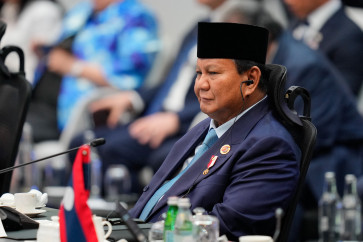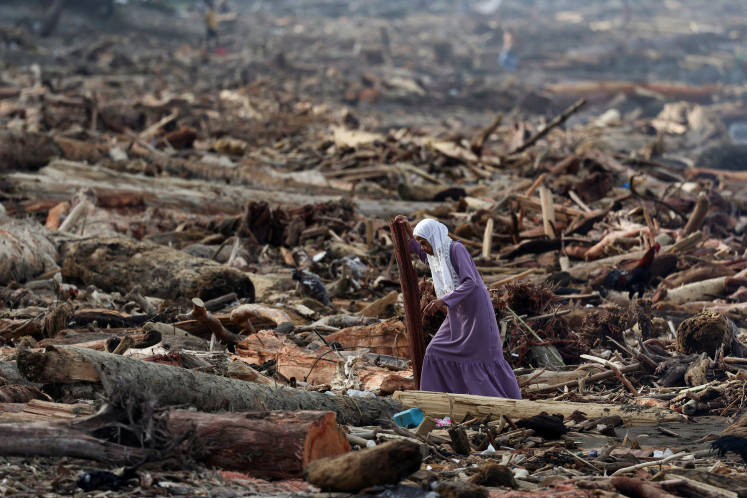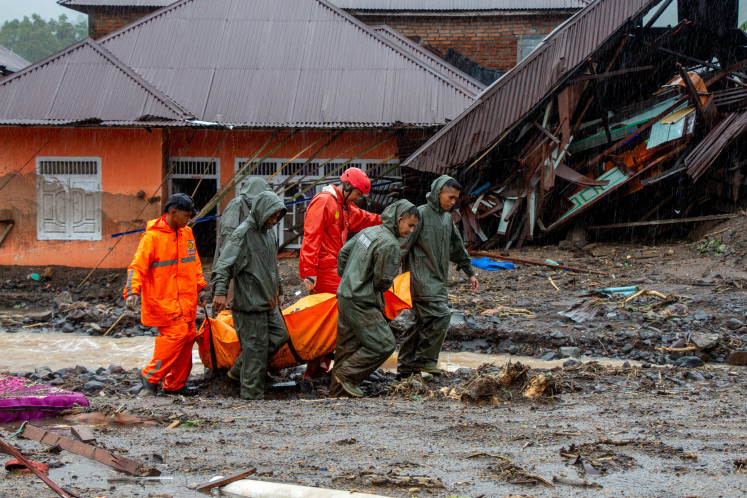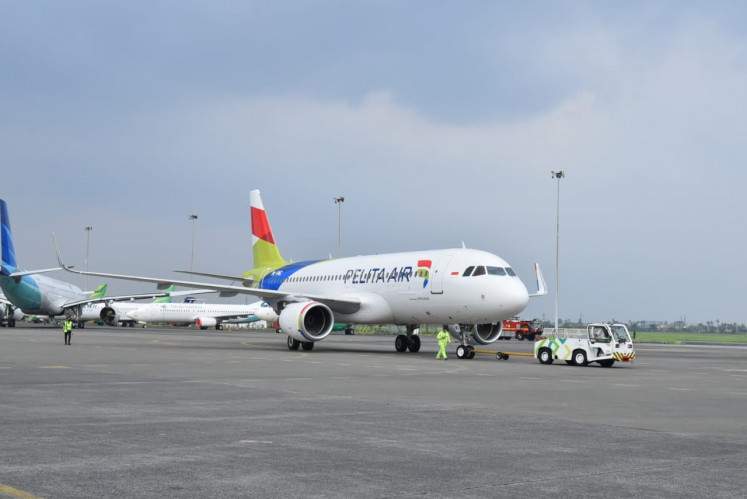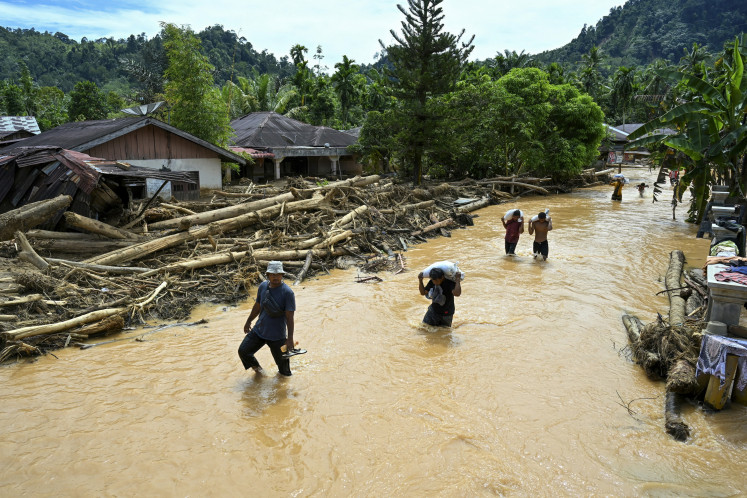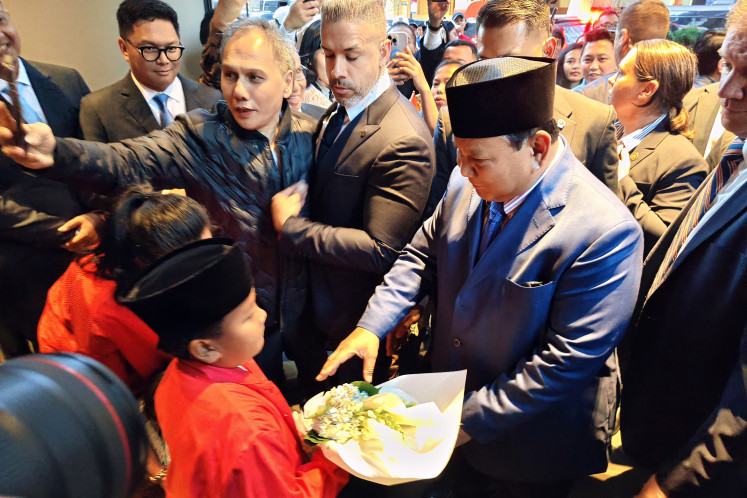Popular Reads
Top Results
Can't find what you're looking for?
View all search resultsPopular Reads
Top Results
Can't find what you're looking for?
View all search resultsIndonesia Needs a National Nutrition Resilience Protocol
Change text size
Gift Premium Articles
to Anyone
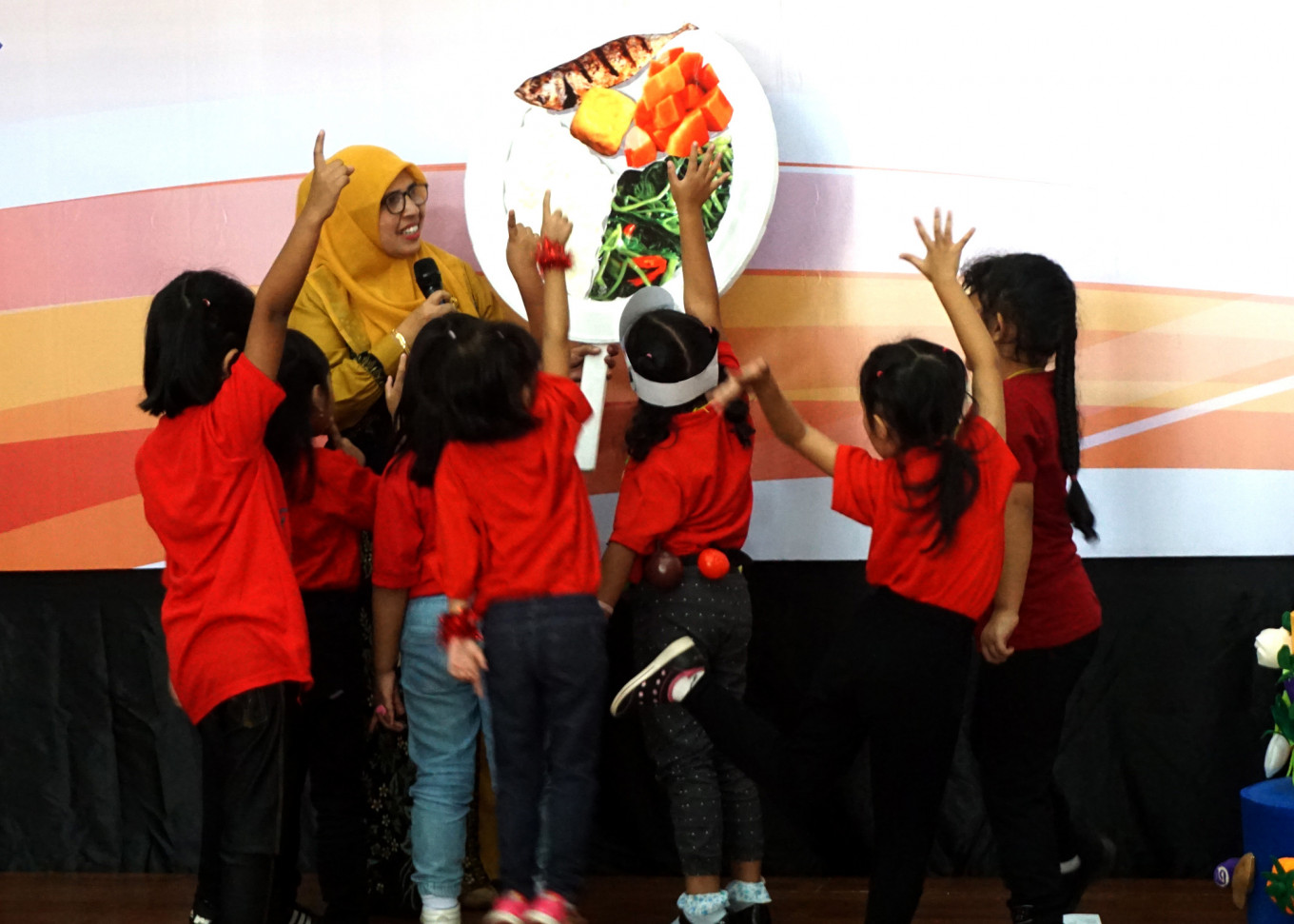 Interactive nutrition education: A preschool teacher introduces children to the “Isi Piringku” (My Plate) program at Batu City Hall, East Java. The program, supported by the Batu city administration and Danone Indonesia, aims to promote balanced nutrition and help prevent childhood stunting, a critical public health issue highlighted in the call for a national nutrition resilience protocol. (JP/Nedi Putra AW)
Interactive nutrition education: A preschool teacher introduces children to the “Isi Piringku” (My Plate) program at Batu City Hall, East Java. The program, supported by the Batu city administration and Danone Indonesia, aims to promote balanced nutrition and help prevent childhood stunting, a critical public health issue highlighted in the call for a national nutrition resilience protocol. (JP/Nedi Putra AW)
I
n a world marked by growing political instability, climate disruption, and volatile global trade, Indonesia’s food and nutrition security can no longer be left to chance.
The conflict resulting in disruption in the Middle East are only the latest reminders that our access to food and nutritional supplies is vulnerable to geopolitical tremors far beyond our borders. And unlike inflation or political unrest, nutritional crises rarely scream attention.
This silent and insidious nature of nutritional vulnerability demands a response framework that is as proactive and coordinated as our disaster preparedness systems.
Just as Indonesia has built institutional resilience against earthquakes, floods, and pandemics, the same level of strategic foresight must now be extended to protect the nation’s food and nutrition systems.
The growing threat is not only about scarcity but about the invisible erosion of human potential, particularly in children, when access to adequate nutrition is unavailable.
Indonesia however, is not starting from zero.
We already have a well-established disaster response system under the National Agency for Disaster Countermeasure (BNPB) and a social protection system such as the Non-Cash Food Assistance (BPNT or Bantuan Pangan Non-Tunai) that reaches millions of households across the country.
The recent establishment of the National Nutrition Agency (BGN-Badan Gizi Nasional) is not only timely, but it could also be transformative.
By having a dedicated institution tasked with overseeing Indonesia’s nutrition agenda, the country would gain a central command structure capable of coordination across ministries, tracking risk indicators, and activating emergency nutrition responses when needed.
Countries such as India and Brazil have shown how strong national nutrition governmental bodies can dramatically accelerate multisector progress when equipped with proper authority.
What we just lack now is a national protocol for early detection and rapid response.
Indonesia clearly needs a National Nutrition Resilience Protocol that comes in the form of a structured, multi-agency system designed to monitor nutritional risks, activate responses, and deliver life-saving interventions to the most vulnerable groups.
Protocol Tracking System
First of all, the protocol must be built on real-time monitoring towards nutritional risk thresholds.
Our government already monitors rice availability and chili prices weekly, but nutrition is more than just food availability.
The protocol should track key indicators which signal emerging risks to nutrition security, such as global food price fluctuations, climate-related crop failures, import dependency on essential staples, local supply chain disruptions, and micronutrient stock levels.
Because early warning is critical to prevent invisible yet irreversible damage.
Rice, for example, our country’s primary staple, is becoming increasingly vulnerable to climate shocks like El Niño, which in 2023 caused yield declines in major rice-producing regions such as Central Java and South Sulawesi.
Not only pushing up prices, but also affecting the availability of fortified rice used in social assistance programs like the BPNT.
Disruptions in the production or distribution of other fortified foods, such as iron-fortified products and milk for under-five to school-aged children or vitamin A supplements for toddlers, can quietly derail long-term public health progress.
By systematically tracking these indicators, the protocol enables targeted and rapid responses in releasing government rice reserves, subsidizing fortified foods, or scaling up local production to safeguard nutrition before crises can escalate.
Second, when these indicators cross critical thresholds, the protocol must trigger adaptive social protection. This would forego waiting for a formal crisis declaration, and will instead immediately activate measures such as topping up BPNT balances for targeted households, helping them in purchasing nutrient-rich foods or even direct transfers of fortified food packages for children under-five during periods of prolonged price spikes as well as transport disruptions.
Third, the state must coordinate with the private nutrition and fortified food industry, particularly the producers of essential items like fortified milk, iron-folic acid tablets, iodized salt, and complementary infant food.
The protocol should include local supply during shortages, pre-positioning of stockpiles in vulnerable provinces or hard-to-reach areas, and the importance of joint communication strategies to combat misinformation about product safety or usage.
Fourth and most critically, the protocol must prioritize targeted nutritional support for biologically vulnerable groups.
This includes infants and children under-five, who suffer irreversible damage even from short-term malnutrition, pregnant and lactating mothers, whose nutritional intake directly affects fetal development and breastfeeding quality.
These groups should not only be beneficiaries but should be central to the protocol’s operational design. Health centers and schools can serve as distribution hubs for fortified foods and supplements. Posyandu can lead door-to-door outreach. Digital health platforms can be used for reminders, eligibility checks, and feedback loops.
Integrated Health Indicators
Since nutrition and health are inseparably linked, this protocol must also incorporate the monitoring of key health indicators, especially among vulnerable and priority populations. Which includes, infants and toddlers, pregnant and lactating mothers, adolescent girls, and the elderly.
A rise in anemia prevalence, wasting, stunting rates, or low birth weights can serve as sentinel signs of underlying nutritional stress in the population.
To maximize its impact, the nutrition resilience protocol should also be strategically linked to the national agenda of eradicating high-prevalence diseases like stunting, malaria, and the alarmingly relevant tuberculosis (TBC), as this is also a key health priority under President Prabowo Subianto’s administration.
In Indonesia, undernutrition is estimated to contribute to over 50 percent of active TBC cases. Through embedding nutritional surveillance and intervention within the broader TBC strategy, the protocol becomes a vital tool in reducing vulnerability, improving treatment outcomes, and preventing relapse.
During COVID-19, Indonesia demonstrated its ability to mobilize multi-sectoral responses under pressure. But what the country still lacks is a permanent, science-based protocol for nutritional response, one that operates between emergencies, not just during them. And the support of academicians is critical in developing such a protocol.
This is not just about protecting health, it’s about protecting national resilience from inside out. Food systems may fail, but nutrition systems must not. A National Nutrition Resilience Protocol would not be a luxury policy; it would be a national shield. Just as we plan for floods and earthquakes, we must now plan for food insecurity, micronutrient shortages, and rising child malnutrition during global turmoil.
In doing so, Indonesia will be taking an essential step toward becoming not only food sovereign, but nutrition secure, even in the most unpredictable global conditions.
Because when the world becomes unstable, the most strategic act of leadership is to make sure our people will as still eat well, grow strong, and remain unshaken from within.
Prof. Nila F Moeloek is Minister of Health of The Republic of Indonesia 2014-2019 and Chair of Advisor the Indonesia Health Development Center (IHDC)
Ray Wagiu Basrowi, MD, PhD is the Founder of Health Collaborative Center and Executive Director of the Indonesia Health Development Center (IHDC)
The ideas expressed here do not represent The Jakarta Post’s views and policies.



